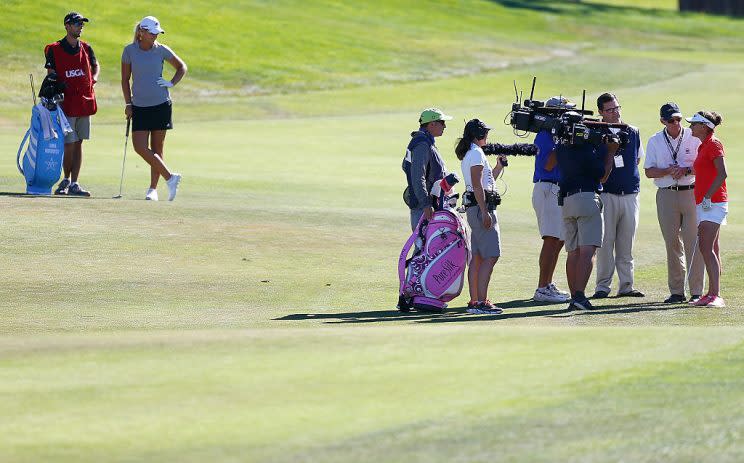USGA did right by the rules at Women's Open, but changes needed

They got it right, but it feels wrong.
The USGA had to issue a two-stroke penalty to Anna Nordqvist for grounding her club in a bunker on the second hole of a three-hole, aggregate-score playoff at the U.S. Women’s Open. Rule 13-4 in the Rules of Golf isn’t ambiguous, and it doesn’t factor in intent. The penalty is clear.
However, it wasn’t clear to Nordqvist, who finished regulation tied with Lang at 6-under 282, that she had even broken the rule on her second shot into the par-4 17th at CordeValle. It was clear, though, to the Fox Sports cameraman who focused his lens on the Swede’s ball as she prepared to hit the 5-iron approach. The high-definition shot didn’t even need to be zoomed in; it was apparent Nordqvist’s club had touched the sand.
Further complicating the issue, the USGA didn’t disclose their ruling until both players had hit two shots on the par-5 18th, the scheduled third and final hole of the playoff. To that point, both players thought they’d each made par on the first two holes. The officials told Nordqvist that wasn’t the case, but not until she had hit her third shot. Lang found out before she hit her third shot and played accordingly away from the guarding water hazard to set up a two-putt for the win.
Nordqvist, who handled the whole thing with grace, said that was really the only problem she had with the ordeal. The rules are rules, and she abides by them.
However, this incident marks the second consecutive USGA championship marred by a rules infraction heavily influenced by high-definition video footage.
At the U.S. Open, USGA officials used video review to come to the conclusion that it “more likely than not” that Dustin Johnson caused his ball to move on the fifth green at Oakmont Country Club. After Johnson and playing partner Lee Westwood thought the issue was settled with the walking referee on the hole, USGA officials told Johnson, and eventually the remaining field, that he could incur a one-stroke penalty for that incident. However, they wouldn’t tell Johnson with certainty that he would take a penalty stroke and told him that it would be settled after the round. The USGA rightfully took it on the chin for their handling of the incident. Fortunately, Johnson played so well in the final round that the penalty stroke just seemed like a cheap shot to prove a point. Johnson didn’t care; he had the trophy anyhow.
That wasn’t the case here. The penalty mattered. Basically, it was all that mattered. The USGA, however, did its best to get the information and a clear ruling out to the players as quickly as possible. Was it perfect? No, and the USGA would acknowledge that. Was it done as well as possible? It seems that way.
Now, golf needs to come up with a realistic way to deal with reality.
The reality is that not every shot is caught on camera. There were 156 players in the starting field. The vast majority of their shots never were filmed, much less aired. All told, probably some 1 percent of the shots played in this tournament, the biggest in women’s golf, were zoomed in on as Nordqvist’s fairway bunker shot. If the rules are there to protect the field, then what do the cameras do? In this case, they provided the damning evidence that the human eye couldn’t spot.
For years, I’ve argued that top players should expect to come under more scrutiny for potential rules violations. After all, more of their shots are filmed and the galleries following them are larger. It’s an inherent problem, and there’s not much to do about it. Golfers in the field and fans at home want to know that the rules were enforced as correctly as possible. But it just seems wrong for a player to lose their shot at a major championship because of a few grains of sand seen through a $25,000 camera focused on one of two players on the golf course.
The question is how many rules infractions could a high-definition camera pick up if it were fixed on every shot from a green, bunker or other hazard — the spots where grounding the club matters. It would seem the cameras could probably find a few more per tournament.
The bigger problem, however, seems to be communicating rules violations to the field. The solution also seems simple in concept but difficult in practice. There are a lot of things happening in a golf tournament and a lot of moving parts. A rules review first requires officials to be made aware of a situation, review it, then get the word out to the course to let the player know the ruling. In this case, both players in the playoff needed to know at the same time, and that was beyond the USGA’s control. At the U.S. Open, even more players needed to know what might happen to Johnson.
The simple answer is to halt play until a ruling is made, but that’s impossible on a Thursday or Friday. The more complicated answer probably involves letting players use an app on their phone that tells them of rules and competition issues that affect them.
Golf has backed itself into this corner. The Rules of Golf are often clear, but their enforcement isn’t as obvious as often. Certain statutes of golf’s law could no doubt be clarified, rewritten or altogether deleted, but these two situations at back-to-back national championships make it apparent that the focus should be on enforcing the game’s rules.


